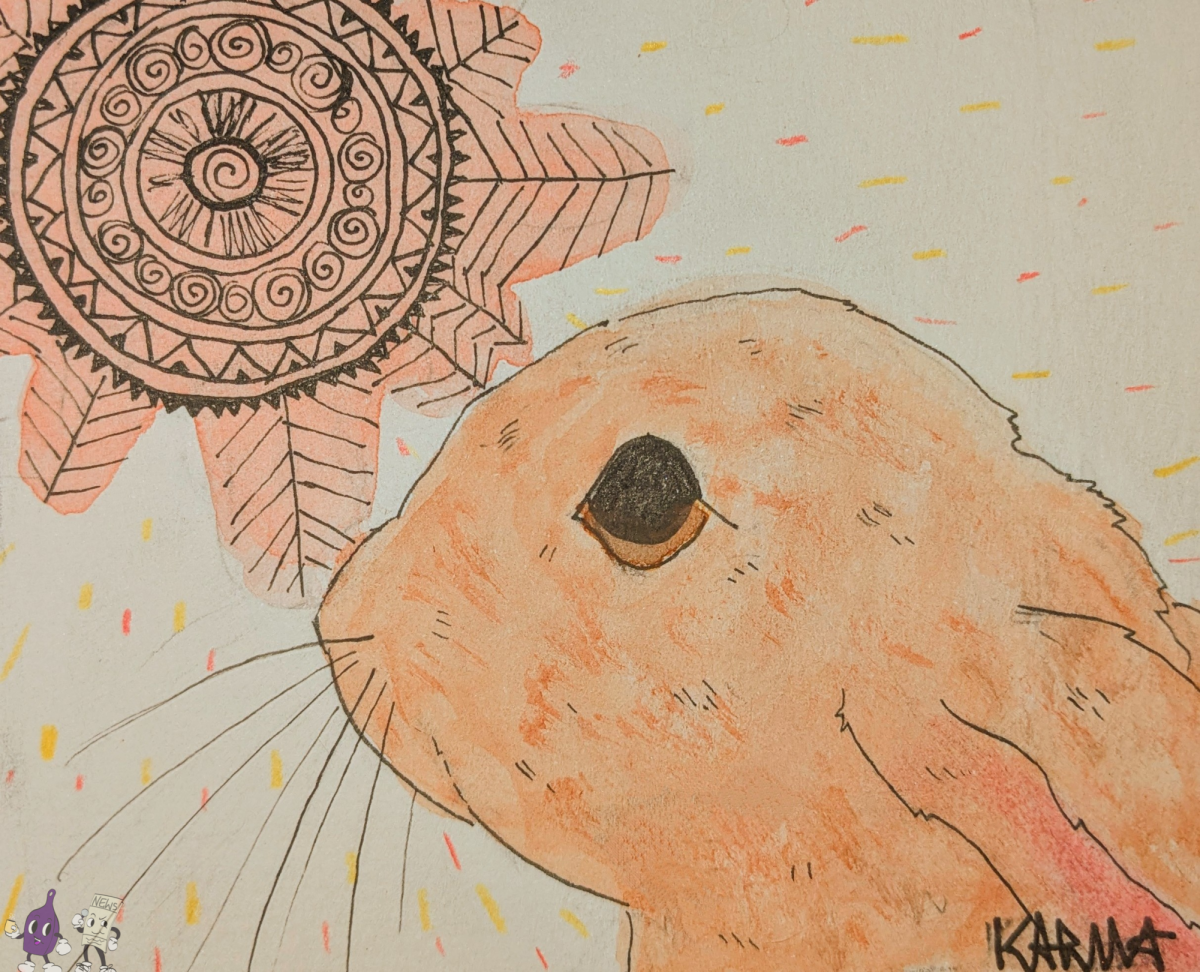
JADE’S JUNGLE
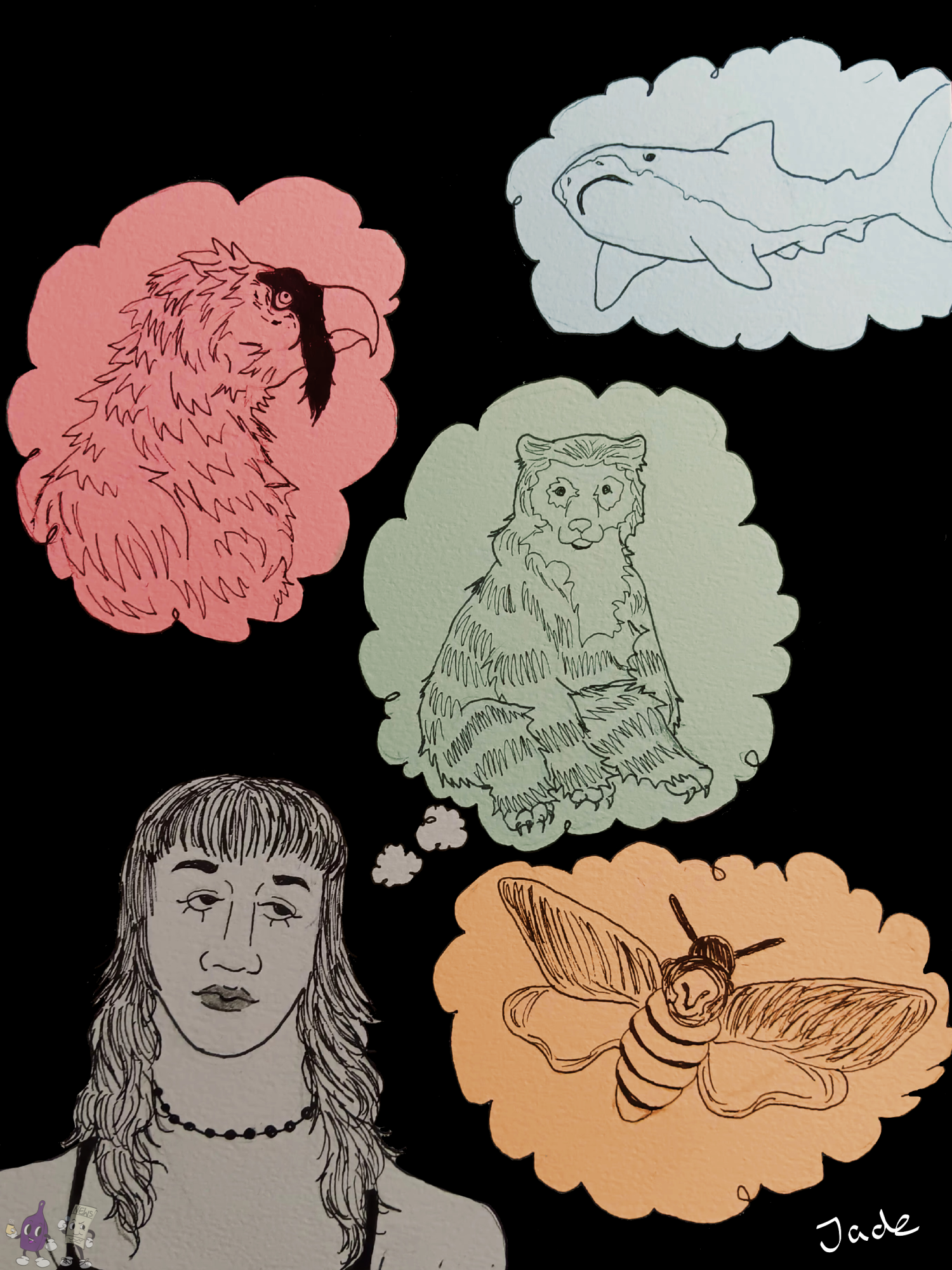
I’ve always loved animals. Since kindergarten I’ve made it my priority to learn about as many animals as I can, which isn’t impossible but there’s a lot of creatures in this world. No matter the case, alive or dead, every animal is important to the world we live in. Down to the smallest ant. Throughout this series, I’ve barely scratched the surface of the billions of animals that I could talk about. So rather than spending the rest of my life trying to teach everyone about the different species of the world, I thought I’d end my jungle tour talking about some of my favorite unique animals.
This journey begins in the high-altitude wilderness where the morning mist clings to the peaks of the Andes Mountains. As we tread along the narrow trails, the slight sound of a rustle in the leaves keeps us from moving. There, right before us, a spectacled bear rests. Its cream colored facial markings popping out from the rest of its black fur. Unlike its fiercer cousins, this bear is content with a diet of fruits and leaves occasionally indulging in a small animal or two. It moves with slow grace as it surveys the peaks. I favor most bears but the Spectacled bear holds a special place among them. There’s something about its lifestyle that makes it stand out. It’s a species that feels both familiar and mysterious, a reminder that not all bears are built for the same world.
Descending from the mountains, we trade misty forests to sunlit rocky cliffs. High above, the wind carries the shadow of another enigmatic predator. The Bearded Vulture soars with effortless elegance, a solitary ruler of the sky. Clutched in its talons is a bone—perhaps from an animal that fell victim to the landscape. Without hesitation, it releases its cargo, watching as it shatters on the sharp rocks below. With eerie patience, the bird spirals downward to claim the rich marrow hidden within the shattered bone. This nature is proof that survival is often a game of intelligence rather than brute force.
Unlike most vultures, the bearded vulture isn’t bald. Due to its diet consisting almost exclusively of bone, it hasn’t evolved to deal with carrion sticking to its feathers.
Leaving the towering cliffs behind, we find ourselves in the dense jungles of central America. Here where colors and chaos reign, a strange ghost flies between the foliage. The Glasswing butterfly, nearly invisible, dances in the air like a spirit untethered from the physical world. No need for bright warnings when its transparency is its greatest weapon. I’ve never really been a fan of butterflies, but discovering the glass butterfly changed my opinion. For a creature to exist just beyond someone’s perception fascinated me. While other butterflies are flashy, this one is subtle, a reminder that not all beauty needs to be loud.
As dusk settles, our path leads us to an open field, where wildflowers sway in the cooling breeze. The silence is soon disturbed by the gentle rhythmic beating of wings. Emerging from the darkness, a visitor arrives– a Death’s-head hawkmoth, drawn by the scent of nectar. It carries an aura of macabre, the skull-like patterns on its back an omen whispered through centuries of folklore. But it isn’t death that it seeks, only honey. A master thief, it infiltrates a nearby beehive, its scent and sound deceiving the colony’s guards. Unaware of the deception, the bees allow the phantom to feed before it vanishes once more into the night. I was first drawn to the death hawk moth for its look alone. Its marking is impossible to ignore making it an immediate eye catcher. Seeing it on the cover for the Silence of The Lambs only cemented its eerie presence. Though only recently had I learned that it was a trickster. That clever deception paired with its haunting appearance makes it one of nature’s fascinating creatures.
The land gives way to the endless sea, where moonlight glistens on rolling waves. Beneath the surface, something stirs. A dark form patrols the waters, stripes barely visible against its sleek body. The tiger shark is both a scavenger and predator. There is no waste in its world, only opportunity. A drifting turtle, an injured fish, even the discarded remains of human pollution— all are fair game. I love all sharks, but the tiger shark has grown on me the most because of its eating habits. It’s even gained the nickname as the “garbage can of the sea.” There’s something almost mythical about it, a creature so relentless that even human relics become part of its feast.
As our journey comes to an end, we realize that the wild is not merely a place of survival but a place of mystery, deception, and ingenuity. From the highest cliffs to the deepest seas, from creatures who vanish like ghosts to those who wield power in unexpected ways, nature is an endless safari. And though we may leave, the players remain, continuing their roles long after we have disappeared from their world.
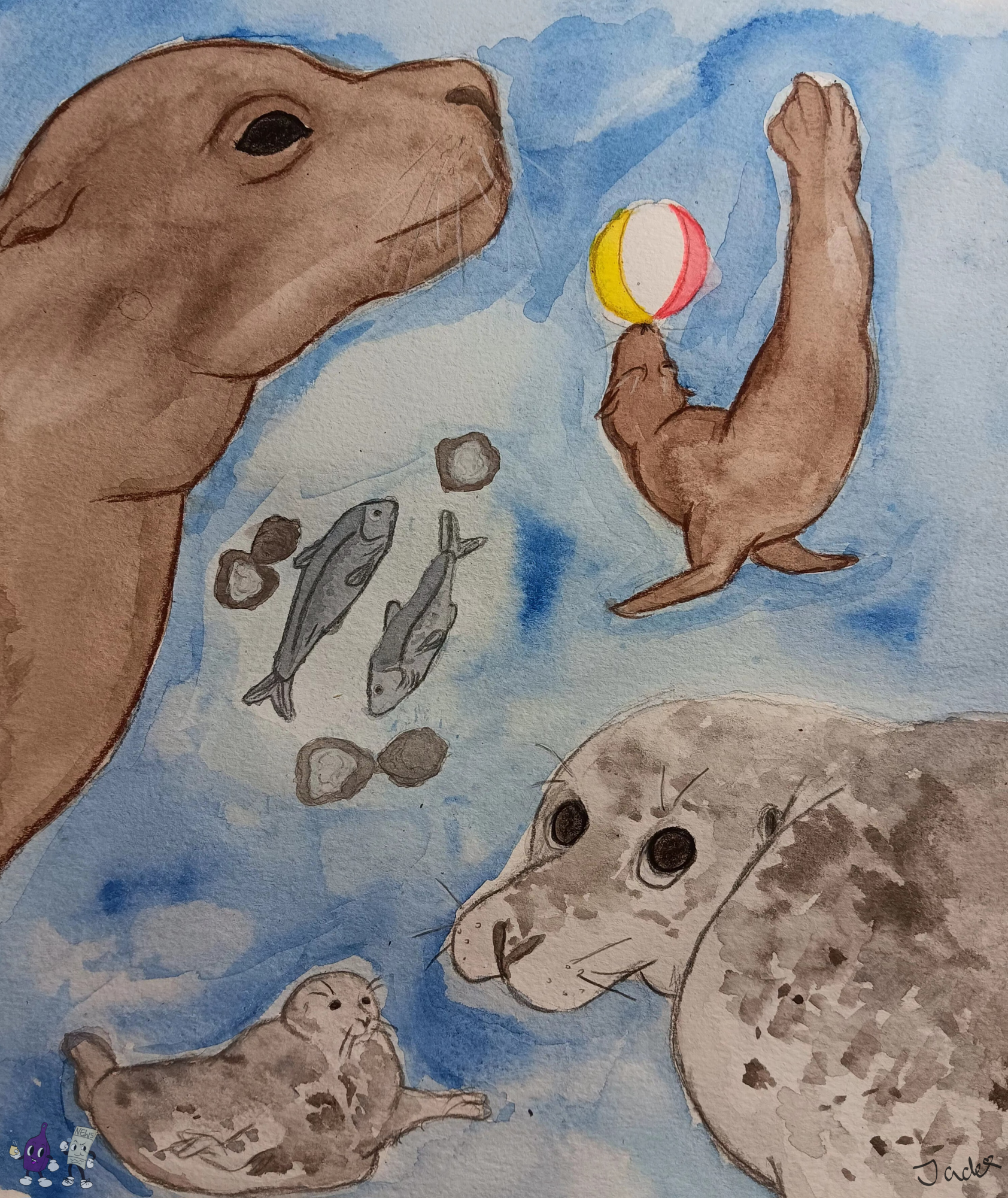
Deep in the sea below, two sleek figures swim effortlessly through the waters, the current guiding them along. Though they share a similar form, the two are quite different. One moves with a powerful deliberate stroke, using its strong front flippers to propel itself forward, while the other relies on swift motions on their hind limbs. As they swim, their eyes scan the depths, searching for prey. Suddenly, a school of fish flickers into view. With a sudden burst of speed, they dive. One twisting and turning with acrobatic finesse, the other surging forward like a torpedo. In mere moments, the hunt is over. Seals and sea lions may seem alike at first glance; however, despite their shared lineage in the Pinniped family, key differences set them apart.
Seals belong to the Phocidae family and are distinguished from the lack of a visible ear. Rather, they have holes on the sides of their heads which still allow them to hear, as well as be a prevention from water drag. Similarly their bodies are built for aquatic life. With short sturdy flippers that make them agile in water but clumsy on land. Unlike their more mobile relatives, seals have a fused pelvic bone preventing them from walking. Instead, they bounce their bellies against the shore in an awkward yet effective motion. The movement is noted to be called galumphing.
Recorded by the International Fund for Animal Welfare (IFAW) there are 33 species of seals, including the well known harbor, grey, and crabeater seals. While many species inhabit saltwater environments, the Baikal Seal thrives in freshwater lakes. All share the same diet of fish with others branching out their options to squid, shellfish, and even seabirds.
Sea lions, on the other hand, belong to the Otaridae family (a name derived from the Greek word otarion, meaning little ear – a nod to their small external ear flaps). Unlike their earless cousins, sea lions are built for more occasions on land than sea. Thanks to rotating limb structure, they’re able to walk and even run on land with surprising agility. This mobility makes them far more adept at traversing rocky shores and sandy beaches where they often gather in noisy social groups. The National Aquarium noted that “Herds of sea lions can even tally upward of a thousand individuals”.
Compared to their relatives there are only six species: New Zealand, Australian,Galapagos, Californian, South American and Steller sea lions (the latter being the largest of the group). Like seals, sea lions have a diet consisting mostly of fish, but will eat squid and octopus as well.
Though different in form and function, both animals share a common lineage and play vital roles in marine ecosystems. They help regulate fish populations, and in turn serve as prey for larger ocean predators. Whether gliding effortlessly through the depths or basking on sunlit shores, these remarkable creatures showcase the diversity and adaptability of life in the sea.
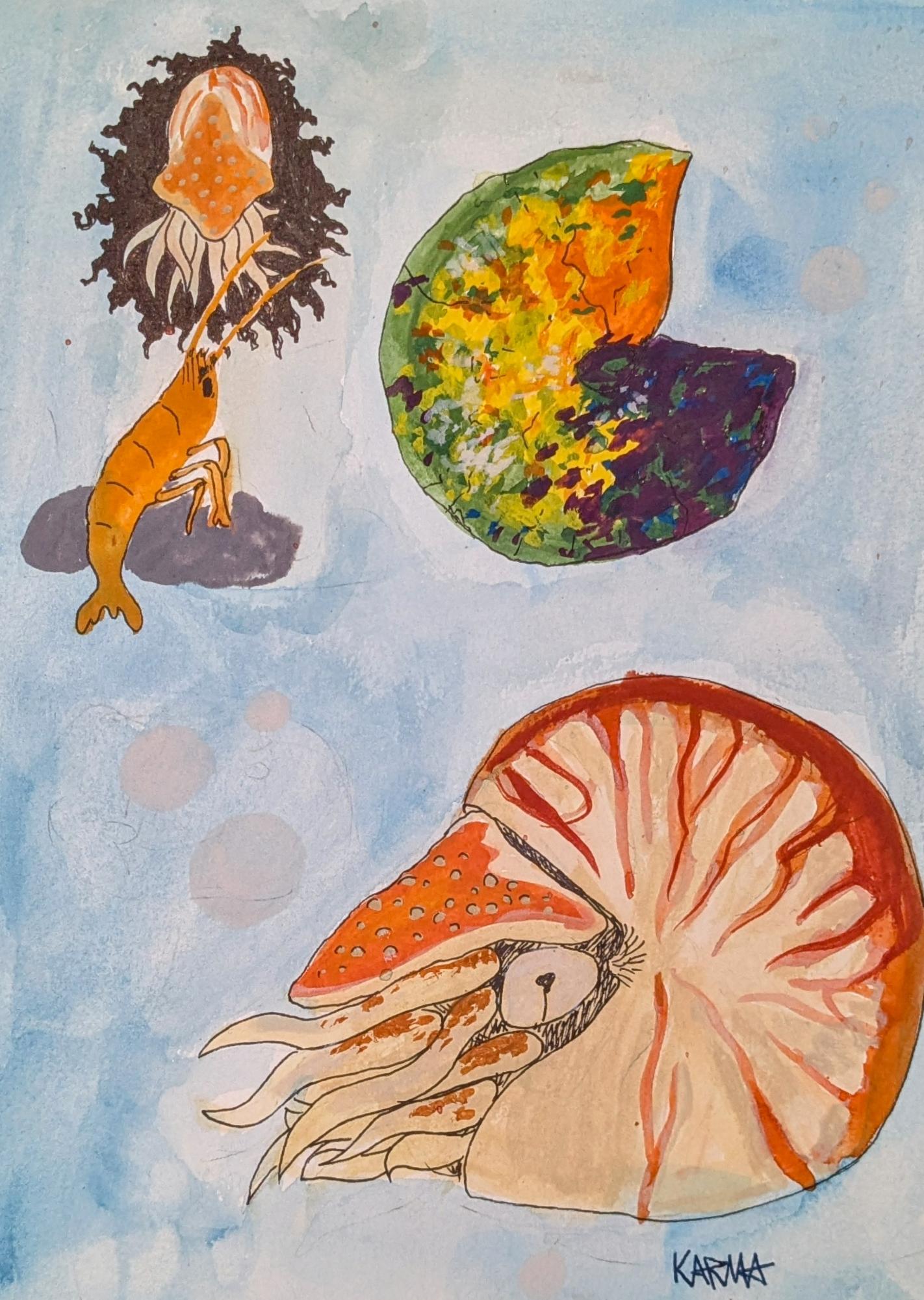
2000 feet below the ocean’s surface and off the slope of a reef in the Pacific, an ancient creature floats, searching the ocean floor. It uses its tentacles to sift through the murky depths until it smells a shrimp peacefully feeding in the shade. The creature shifts its body, moving quickly towards its prey. Before the shrimp even notices, the tentacles of the creature have enveloped it, pulling it into its beak-like mouth. The predator breaks the shrimp open, eating its soft white inside and leaving what’s left of it on the ocean floor.
The Nautilus (Nautilus Belauensis) is one of the most ancient members of the cephalopod family, which includes squids and octopuses. The earliest fossil dates back to the paleozoic era(480-236 Million years ago), predating dinosaurs by about 200 million years. The nautilus has the most tentacles of any of the cephalopods, with an impressive 90 in total, as noted by the Monterey Bay Aquarium. When a nautilus feels threatened, it is able to enclose most of its body underneath its hood.
The nautilus uses water propulsion to move in the water, travelling at the measly speed of 2 mph. Despite their large eyes, the nautilus is only able to see light and shadow, relying on their sense of smell to hunt. Nautili hunt at night, their prey including shrimp, crabs, dead fish, and smaller nautilus. They use their parrot-like beak to break through their tough shells, eating their insides.
The population of nautilus in the wild is tough to gauge; however, they are assumed to be an at risk species due to their peculiar breeding and rate of development. The nautilus takes 10-12 years to mature, only laying 10-18 eggs a year in comparison to most octopi, which lay over 100,000. Its eggs are coated in several layers of leathery membranes which are firmly planted on a solid, shaded/cave like crevice and left to gestate for 12 months. Nautilus shells are also highly sought after as jewelry and decor, which can threaten their populations. Thankfully, most of these shells are harvested from fossils rather than from live specimens.
Despite their peculiarities, the nautilus must be doing something right if they’ve stuck around for over 400 million years.
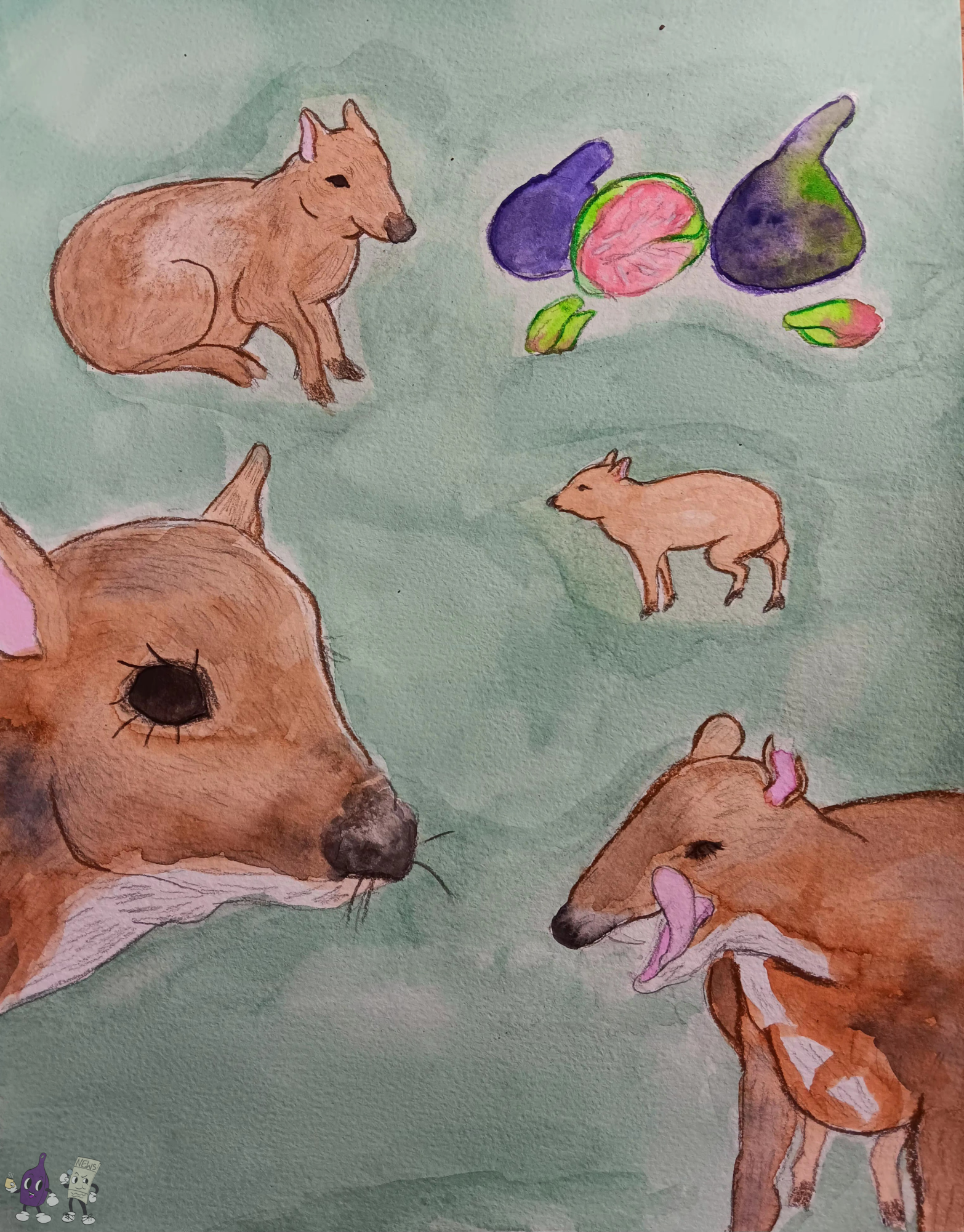
In the shadowy, lush forests of Southeast Asia, a creature no taller than a hare makes its way through the dense undergrowth. Carefully traversing winding roots, its hooved feet make no sound. As it moves through the foliage, it stumbles upon its next meal—a simple yet tasty fig.
Chevrotains, also known as mouse deer, are the smallest ungulates in the world. These shy and elusive creatures stand no more than a foot tall at the shoulder and weigh only a few pounds. Their diminutive size and delicate features make them appear almost otherworldly, yet they are marvels of survival in their dense tropical habitats.
Noted by the Smithsonian Zoo, mouse deer are found in forests ranging from Thailand to Sri Lanka; they are often found living in areas close to water where the vegetation is thick. Their russet-orange fur, accented with a white chest and neck helps them blend seamlessly into the dappled sunlight that filters through the forest canopy. Males possess small tusks—sharp, elongated canines—that are used in fighting other males.
Despite their unassuming appearance, mouse deer are incredibly resourceful. Khao Sok, a national park in Thailand, documents that they feed on fallen fruits like figs and bananas, along with leaves, buds, and shrubs. They rely on a multi-chambered stomach to digest their fibrous diet. Much like larger ruminants, mouse deer chew cud to extract every ounce of nutrition from their meals. They also play a crucial role in their ecosystem by dispersing seeds from the fruits they consume, helping to maintain the health of their forest habitats.
What truly sets mouse deer apart is their extraordinary ability to survive in a world filled with predators. They navigate the forest floor with unmatched agility, their pencil-thin legs allowing them to dart through narrow passages that larger animals can’t follow. Their funniest (yet most useful survival tactic) involves them leaping to the closest body of water to either swim away or sink under for around five minutes until their predators are gone.
In a world where survival demands creativity and resilience, mouse deer are able to thrive due to their resourcefulness. These tiny fascinating creatures are a testament to nature’s ingenuity where they play vital roles in their ecosystems. Though they may be overlooked due to their size, the mouse deer embody the weird traits of the natural world.
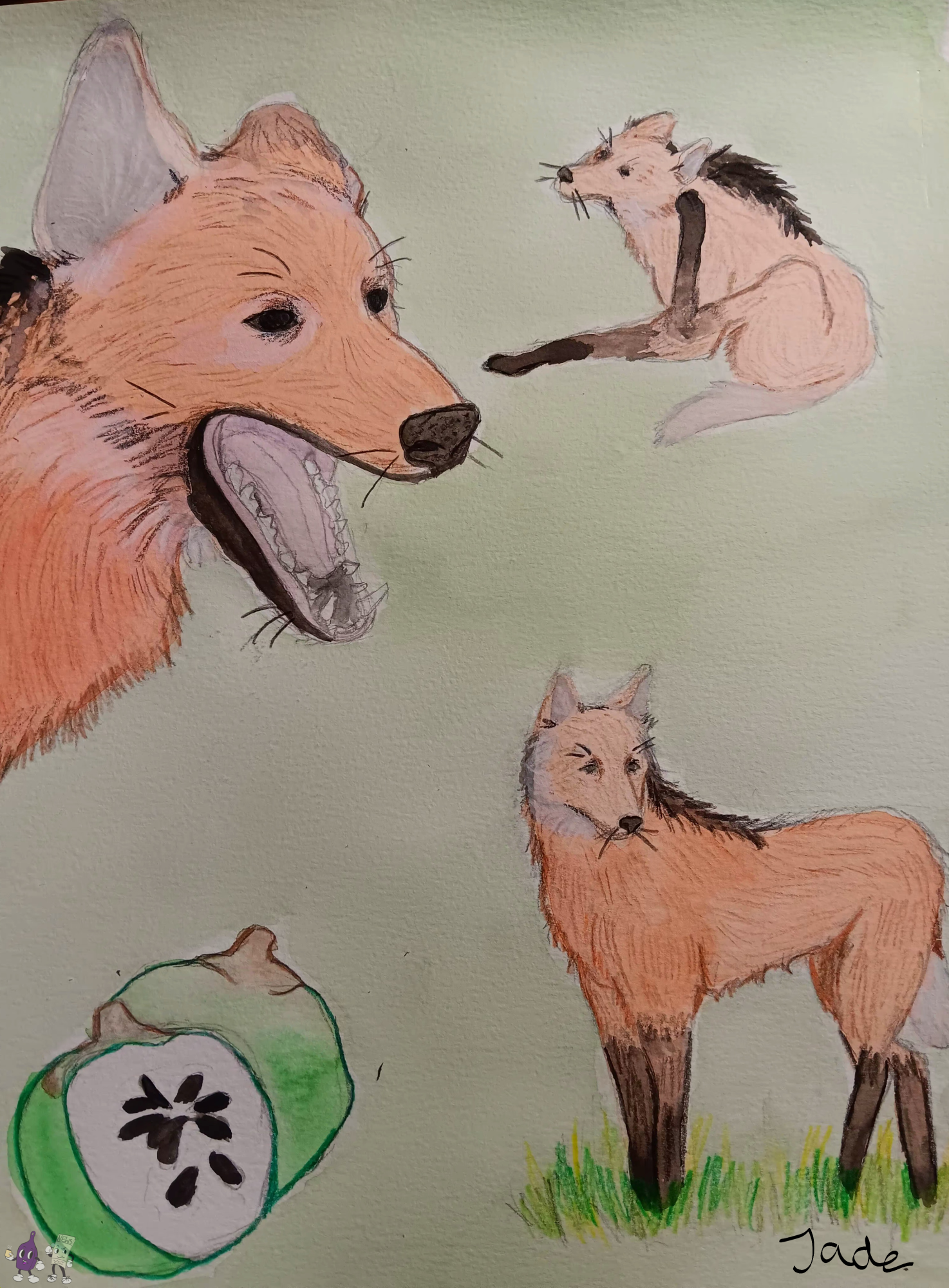
Through the misty highlands and golden grasslands of South America, a peculiar predator prowls. Its long black legs carry it gracefully through the open plains of its terrain. With a fox-like face and ears that swivel at every rustle, it moves like a phantom, silent yet watchful. A sudden pounce, a flash of its sharp teeth, and its prey, a small rodent is snatched from the earth. After its meal, the animal resumes its solitary trek, blending into the landscape.
Despite name and appearance, Chrysocyon Brachyurus (otherwise known as the maned wolf) is neither wolf nor fox.. This South American canine is the sole member of its genus: a true oddity of the animal kingdom. With its slender legs, and red fur crowned by its signature black mane, the maned wolf appears more like a mythological creature rather than a terrestrial animal. Yet its appearance isn’t for show; each feature serves a purpose within its open habitat.
As noted by World Land Trust, an organization that supports wildlife protection, The maned wolf roams the cerrado– a vast tropical savanna ecosystem found in Brazil, Bolivia, Paraguay, and Argentina. This region is marked by dry seasons and scattered trees which perfectly suit the maned wolf’s unique adaptations. Its elongated legs allow it to travel through tall grasses with ease, allowing for a wide vantage point. Primarily nocturnal, the maned wolf spends time patrolling its territory, hunting small mammals, birds, and even fruits. It is so closely tied to its environment, even a fruit– the lobeira or Fruit of the wolf–bears its name.
What truly sets this animal apart, however, is its approach to life and survival. Unlike other canines, the maned wolf is largely solitary. Its hunting technique is methodical (almost catlike), relying on accurate hearing to pinpoint prey hidden in undergrowth.
According to the Smithsonian National Zoo, “Maned wolves rotate their large ears to listen for prey animals in the grass. They tap the ground with a front foot to flush out the prey and pounce to catch it, or they may dig after burrowing prey”. This hybrid behavior reflects its evolutionary history borrowing traits from various species yet standing completely alone.
The maned wolf is a symbol of the wild South American plains. Its existence is a testament to evolution’s creativity, blending traits into an animal that defies classification. As it moves through the open world, each step is a reminder of nature’s power to create such fabled animals.
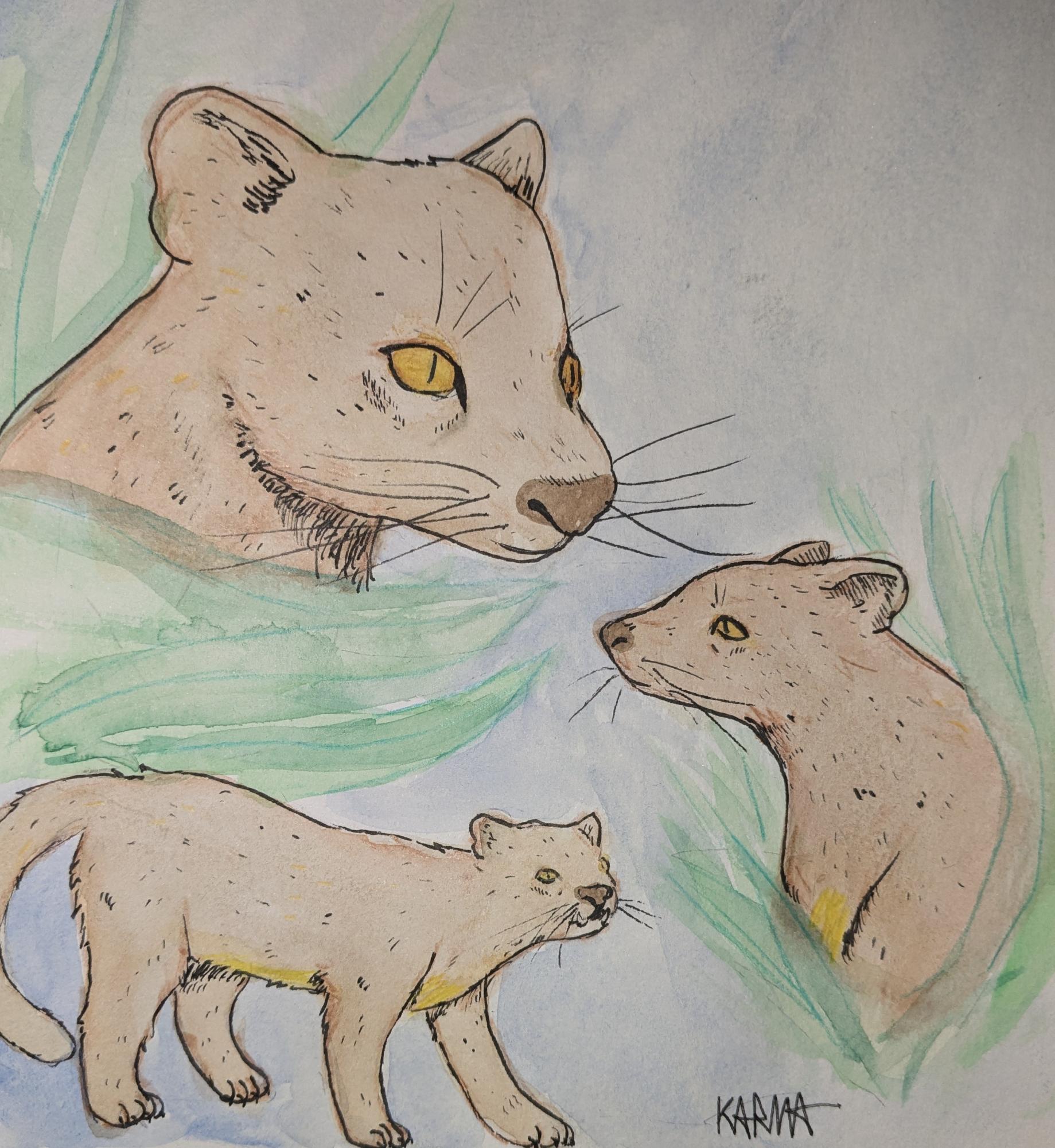
Within an isolated forest in Madagascar, crouched on the branches of a baobab, a predator lies in wait. It’s long and thin, its round ears and large eyes focused in on its target. Without warning, it pounces on an unsuspecting lemur below, dispatching it with its long, retractable claws. It finishes its meal and returns to the treetops, where it will stay until it feels the tightness of hunger again.
The Cryptoprocta ferox, or fossa, is the largest carnivorous mammal of Madagascar. Adults of the species range from 28-31 inches long and 12-20 lbs, with their tail making up half their body length. As with many animals of Madagascar, they are an evolutionary oddity. Their closest relative is the mongoose, but they have their own taxonomic family called Eupleridae or the Malagasy carnivores, composed of the fossa, the falanouc, and the Malagasy civet. The fossa has an odd adaptation—they can release a stinky smell from scent glands located on their chest and base of their tail.
They are both arboreal and terrestrial, capable of navigating Madagascar’s dense forests with ease. Their semi-retractable claws and flexible ankles allow them to climb head first down trees, a rare ability among predators. Fossas play a vital role in maintaining ecological balance, preying on species like lemurs, birds, and reptiles, which helps regulate populations. However, they are currently classified as vulnerable, primarily threatened by human-caused habitat disturbance, including deforestation and fragmentation. Conservation efforts are essential to protect these unique predators and the delicate ecosystems they inhabit.
Fossas have a unique cultural importance to the Malagasy people- the indigenous inhabitants of the island. It is both feared and respected, and to kill a fossa is seen as fady, or taboo. Unfortunately, the loss of habitat of the fossa has forced them to hunt in the poultry farms of Malagasy villages, stressing the relationship between them and the inhabitants.
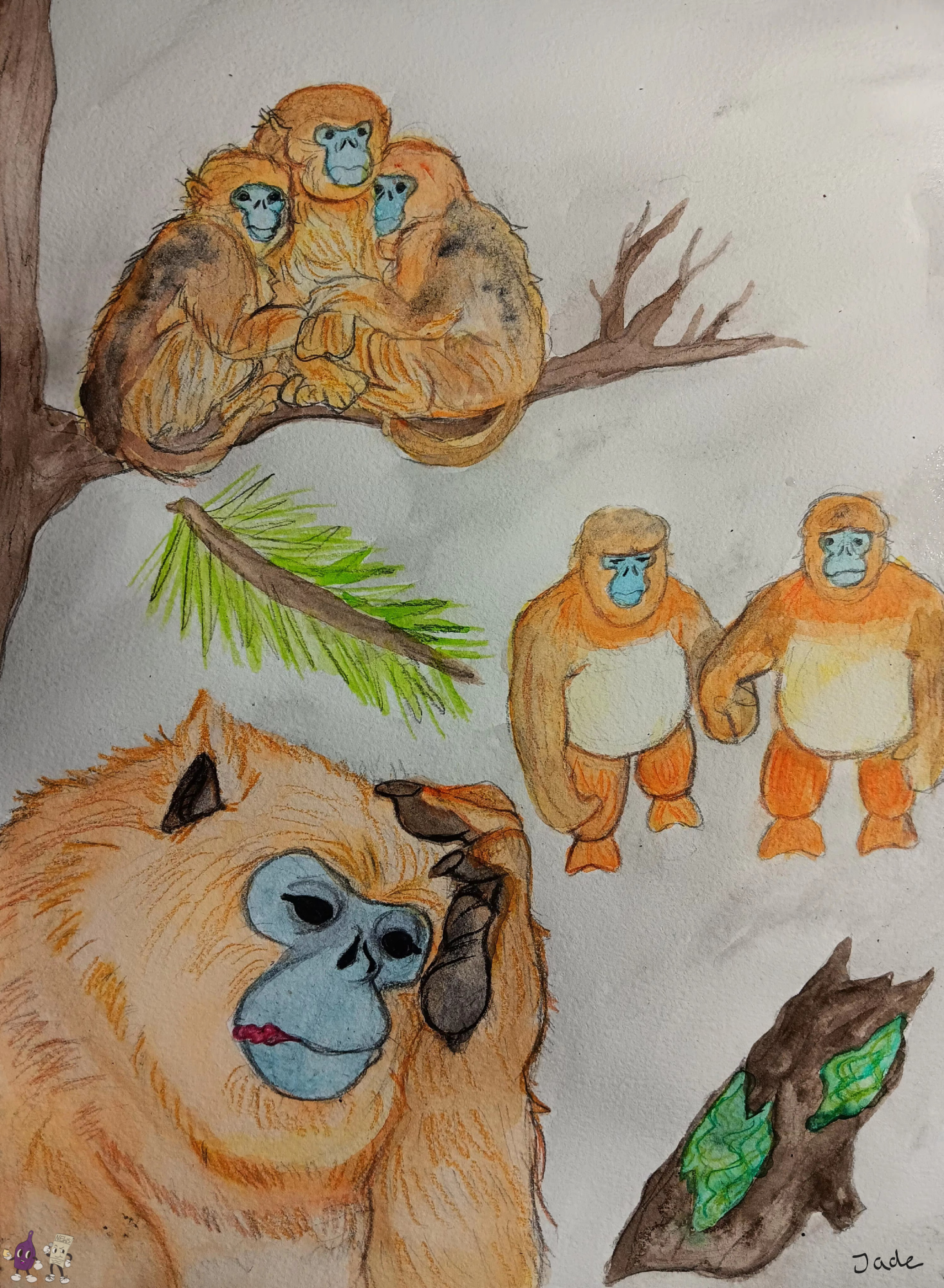
In the high mist-shrouded forests of the mountains, high above the world, a flash of gold moves quickly among the branches. This creature with a face as blue as the winter sky and fur colored as the blazing sun travels with company. When the icy winds nip at their fur, the group gathers close together as a small bundle of warmth and whispers as they survive the cruel cold.
Rhinopithecus roxellana otherwise known as the Golden snub-nosed monkey is unlike any other primate in the world. Not only are they found in more places than their fellow snub-nosed species, but they also live in altitudes where the temperature reaches below freezing-.. Remarked by the New England Primate Conservancy, “They can even be found at altitudes of 6,000–10,000 feet (1,800–3,000 m) above sea level, where temperatures reach as low as 17.1°F (−8.3°C)”
Their thick, golden orange fur provides insulation against the brutal temperatures. As for their thin noses and the blue pigmentation of their faces’, scientists aren’t sure of their purposes. People have argued that their flat-open nostrils prevent them from getting frostbite, similar to humans with narrow noses. As for their blue pigmentation, the closest explanation could be the Tyndall effect. Discovered by John Tyndall in 1859 discovered that through light shorter blue wavelengths are scattered more strongly than red wavelengths. In other words, their faces appear blue similar to how the sky is.
It’s also believed that sightings of these monkeys may have inspired folklore and legends throughout Chinese history. With their golden fur, expressive faces, and agile movements, the Golden snub-nosed monkey is thought to have inspired myths of Sun Wukong, the Monkey King in the classic tale Journey to The West. Additionally, the elusive nature of these monkeys may have fueled local tales of wild men or “yeren” mysterious human-like creatures said to have orange fur as well as roam throughout the forests. A possible explanation for these suspicions is the fact these monkeys are the only primates in the world to walk upright through snow, a behavior that could easily give the impression of a humanoid figure.
From its striking appearance to its questionable behaviors, the Golden snub-nosed monkey bridges the gap between nature and myth, leaving an indelible mark on the wild forests it inhabits and the cultural fascination of those who share its world.
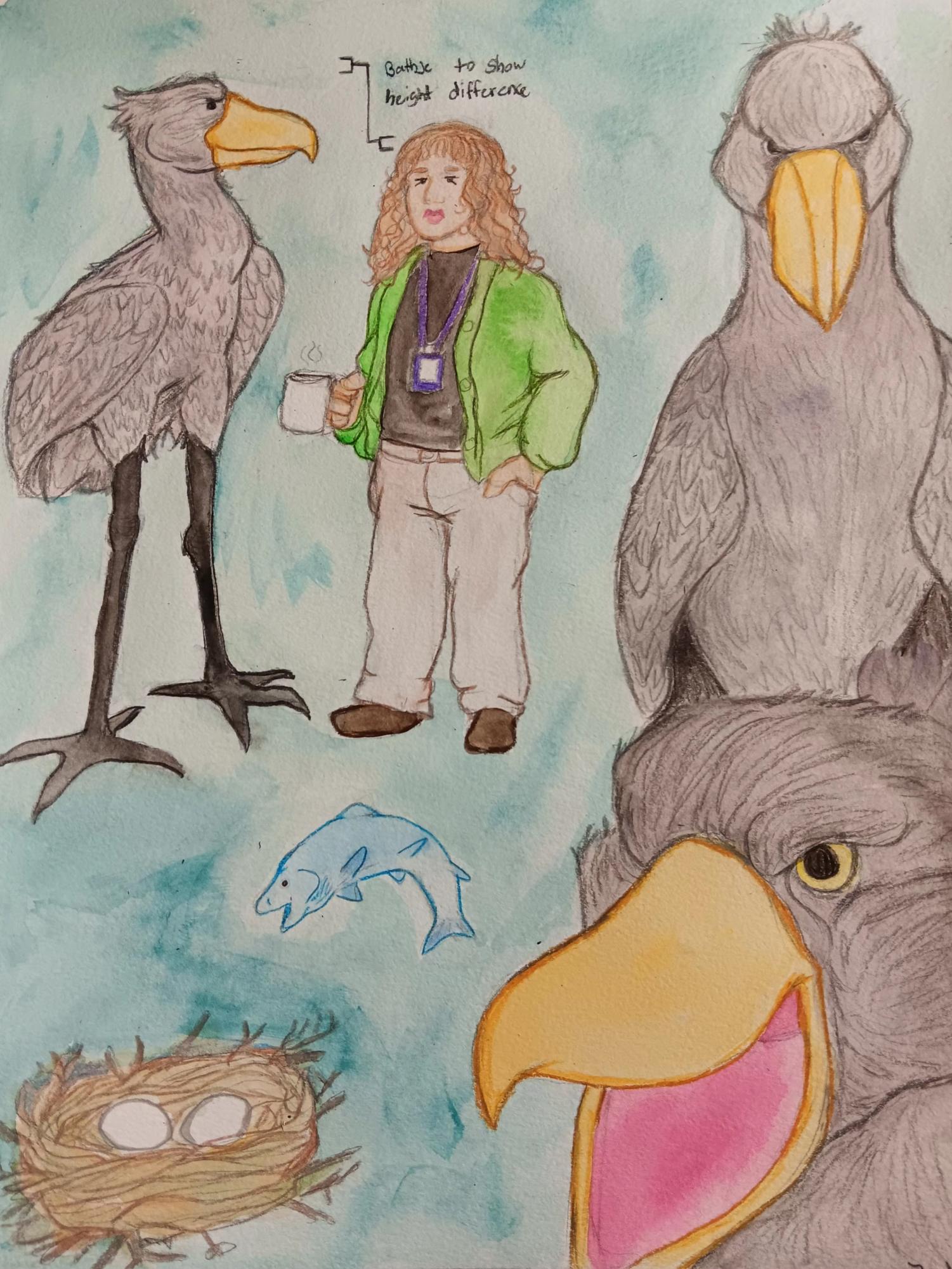
Deep in the heart of a misty swamp, standing motionless between looming cypress trees is a lone bird observing the water. Its large, piercing eyes scanned the murky waters, as its beak, a formidable shoe-shaped weapon, remained poised above the water. A sudden ripple disturbs the stillness, and ever so slightly, the bird tilts its head, calculating its next move. In one swift motion, its beak plunged, splashing water in its wake. With a fish clamped tightly in its iron grip it merges into the stillness of the swamp.
The Shoebill, also known as the Balaeniceps rex, has become internet-famous in recent years, captivating viewers worldwide with its eerie appearance and unnerving nature. With its large pale yellow eyes and a permanent intense glare, the Shoebill looks like something out of a cryptid sighting, and the internet has quickly taken notice. With videos and photos of the bird standing completely motionless, making its rounds around Tiktok. While this behavior is funny, it’s the tactic they use while hunting. Ivan Phillipsen, a naturalist with a PH.D in zoology, has described that the bird will either stand and wait for its prey, staring at the dark water at its feet for hours, or slowly walk through its territory, checking the water as it goes. This behavior is perfectly suited to its environment. As noted by BirdLife International, “The Shoebill can be found in freshwater swamps in Africa from South Sudan to Zambia,” Where dense foliage and murky waters make patience a crucial tool for a predator such as the Shoebill.
With its stature, towering up to five feet tall, and its signature wedge-shaped bill, the Shoebill is a bird that catches the eye. Its feathers, a soft gray slate, stand in striking contrast against the lush greens of its swampy domain. Despite its comical viral reputation, the Shoebill is a master of stealth and patience within its home, earning its spot as an effective hunter in Africa’s wetland biomes.
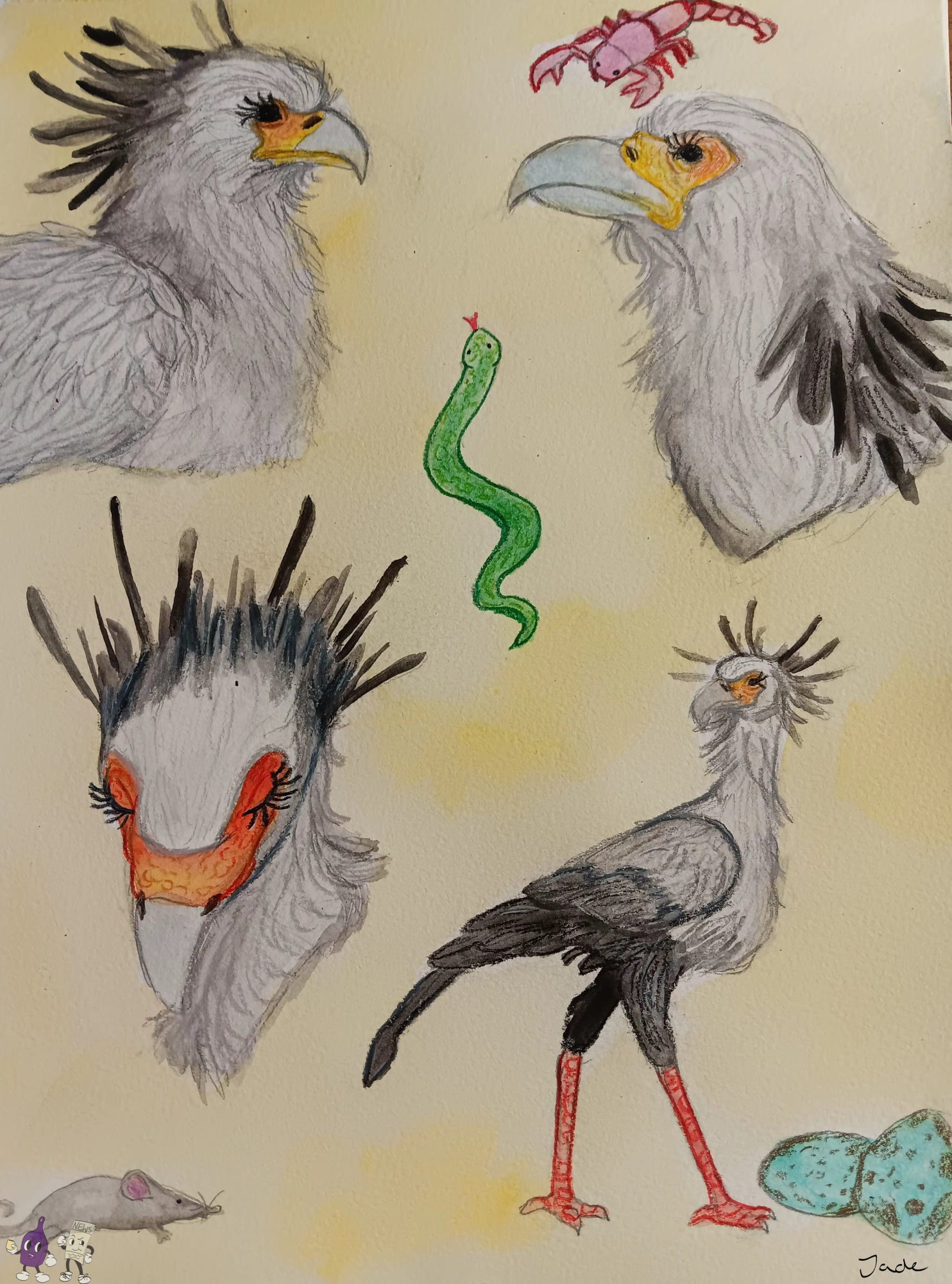
Through the golden grasses of the African savannah, a unique bird of prey stalks for its next meal. Upon finding a snake slithering along the rough terrain, it charges forward, fluttering its wings before forcefully stomping it into the ground. After a few kicks to the head, the snake is eaten as if it were fried noodles. After the bird’s striking display of skill and precision, it keeps to its stroll through the grass.
The Secretary bird, or Sagittarius serpentarius, is known not only for its distinct hunting habits but also for its alluring appearance. Its most prominent features being its stork-like legs clad with black feathers that look like short pants, and their dark eyelashes that frame their large expressive eyes. Though these features sound silly, they help the bird through its open land habitat.
Living South of the Sahara desert, Secretary birds can be found lounging in areas scattered with acacia trees, scrub and short grasses. The Peregrine Fund, a non-profit organization dedicated to the conservation of birds has noted that they will occasionally find their way into airfields and pasture lands. Their day begins shortly after dawn where they’ll begin to scavenge their territory for food, often covering more than twelve miles a day. They’ll spend the whole day searching for food, taking breaks in the shade during the hottest hours of the day and returning to their roost as dusk sets in.
But what truly sets the secretary bird apart from its fellow birds is its approach to hunting. Unlike other raptors, this bird sticks to the ground, only flying when it is dire. And both its talons and beak were made for striking its prey. Described by the San Diego Zoo, “They catch prey by chasing it down, and then they either strike it with their bill or stomp on it until the prey is dead or stunned enough for the bird to swallow, usually whole.” As brutal as it sounds it’s effective for them.
Though often solitary in its daily patrol of the savannah, the secretary bird is a skilled and efficient predator. Each step it takes on its trek highlights its dual nature as a fierce hunter and icon of the bird world.



